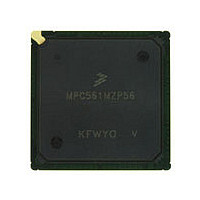MPC561MZP56 Freescale, MPC561MZP56 Datasheet - Page 660

MPC561MZP56
Manufacturer Part Number
MPC561MZP56
Description
Manufacturer
Freescale
Datasheet
1.MPC561MZP56.pdf
(1420 pages)
Specifications of MPC561MZP56
Cpu Family
MPC56x
Device Core
PowerPC
Device Core Size
32b
Frequency (max)
56MHz
Interface Type
QSPI/SCI/SPI/UART
Total Internal Ram Size
32KB
# I/os (max)
56
Number Of Timers - General Purpose
22
Operating Supply Voltage (typ)
2.6/5V
Operating Supply Voltage (max)
2.7/5.25V
Operating Supply Voltage (min)
2.5/4.75V
On-chip Adc
2(32-chx10-bit)
Instruction Set Architecture
RISC
Operating Temp Range
-40C to 125C
Operating Temperature Classification
Automotive
Mounting
Surface Mount
Pin Count
388
Package Type
BGA
Program Memory Type
ROMLess
Program Memory Size
Not Required
Lead Free Status / RoHS Status
Not Compliant
Available stocks
Company
Part Number
Manufacturer
Quantity
Price
Company:
Part Number:
MPC561MZP56
Manufacturer:
Freescale Semiconductor
Quantity:
10 000
Company:
Part Number:
MPC561MZP56R2
Manufacturer:
Freescale Semiconductor
Quantity:
10 000
- Current page: 660 of 1420
- Download datasheet (11Mb)
Queued Serial Multi-Channel Module
executed again. SPE is not cleared by the QSPI. New receive data overwrites previously received data
located in the receive data segment.
Wraparound mode is properly exited in two ways:
15.6.8
MODF is asserted by the QSPI when the QSPI is the serial master (MSTR = 1) and the slave select
(PCS0/SS) input pin is pulled low by an external driver. This is possible only if the PCS0/SS pin is
configured as input by QDDR. This low input to SS is not a normal operating condition. It indicates that
a multimaster system conflict may exist, that another MCU is requesting to become the SPI network
master, or simply that the hardware is incorrectly affecting PCS0/SS. SPE in SPCR1 is cleared, disabling
the QSPI. The QSPI pins revert to control by QPDR. If MODF is set and HMIE in SPCR3 is asserted, the
QSPI generates an interrupt to the CPU.
The CPU may clear MODF by reading SPSR with MODF asserted, followed by writing SPSR with a zero
in MODF. After correcting the mode fault problem, the QSPI can be re-enabled by asserting SPE.
The PCS0/SS pin may be configured as a general-purpose output instead of input to the QSPI. This inhibits
the mode fault checking function. In this case, MODF is not used by the QSPI.
15.7
The dual, independent, serial communication interface (DSCI) communicates with external devices
through an asynchronous serial bus. The two SCI modules are functionally equivalent, except that the
SCI1 also provides 16-deep queue capabilities for the transmit and receive operations. The SCIs are fully
compatible with other Freescale SCI systems. The DSCI has all of the capabilities of previous SCI systems
as well as several significant new features.
Figure 15-24
15-42
•
•
The CPU may disable wrap-around mode by clearing WREN. The next time end of the queue is
reached, the QSPI sets SPIF, clears SPE, and stops.
The CPU sets HALT. This second method halts the QSPI after the current transfer is completed,
allowing the CPU to negate SPE. The CPU can immediately stop the QSPI by clearing SPE;
however, this method is not recommended, as it causes the QSPI to abort a serial transfer in
process.
Serial Communication Interface
Mode Fault
is a block diagram of the SCI transmitter.
MPC561/MPC563 Reference Manual, Rev. 1.2
Figure 15-25
is a block diagram of the SCI receiver.
Freescale Semiconductor
Related parts for MPC561MZP56
Image
Part Number
Description
Manufacturer
Datasheet
Request
R

Part Number:
Description:
MPC5 1K0 5%
Manufacturer:
TE Connectivity
Datasheet:

Part Number:
Description:
MPC5 500R 5%
Manufacturer:
TE Connectivity
Datasheet:

Part Number:
Description:
MPC5 5K0 5%
Manufacturer:
Tyco Electronics
Datasheet:

Part Number:
Description:
MPC5 5R0 5%
Manufacturer:
Tyco Electronics
Datasheet:

Part Number:
Description:
MPC5 50K 5%
Manufacturer:
Tyco Electronics
Datasheet:

Part Number:
Description:
MPC5 1R0 5%
Manufacturer:
Tyco Electronics
Datasheet:

Part Number:
Description:
TOWER ELEVATOR BOARDS HARDWARE
Manufacturer:
Freescale Semiconductor
Datasheet:

Part Number:
Description:
TOWER SERIAL I/O HARDWARE
Manufacturer:
Freescale Semiconductor
Datasheet:

Part Number:
Description:
LCD MODULE FOR TWR SYSTEM
Manufacturer:
Freescale Semiconductor
Datasheet:

Part Number:
Description:
DAUGHTER LCD WVGA I.MX51
Manufacturer:
Freescale Semiconductor
Datasheet:

Part Number:
Description:
TOWER SYSTEM BOARD MPC5125
Manufacturer:
Freescale Semiconductor
Datasheet:












